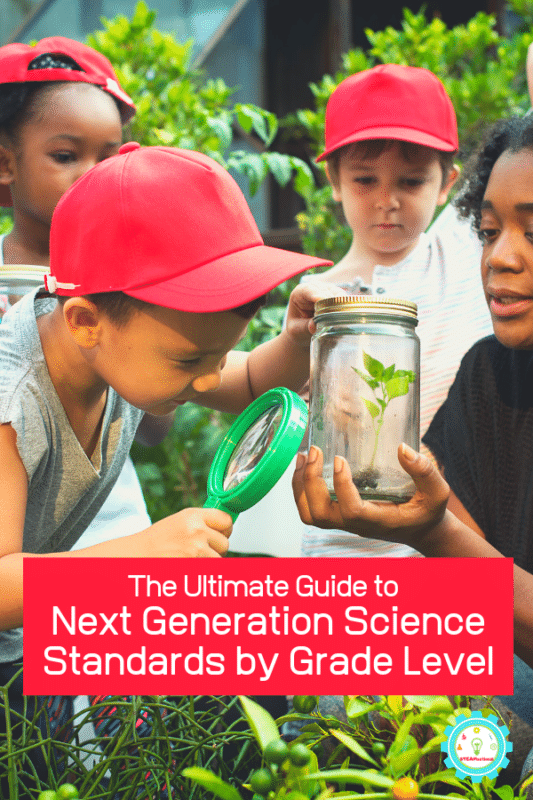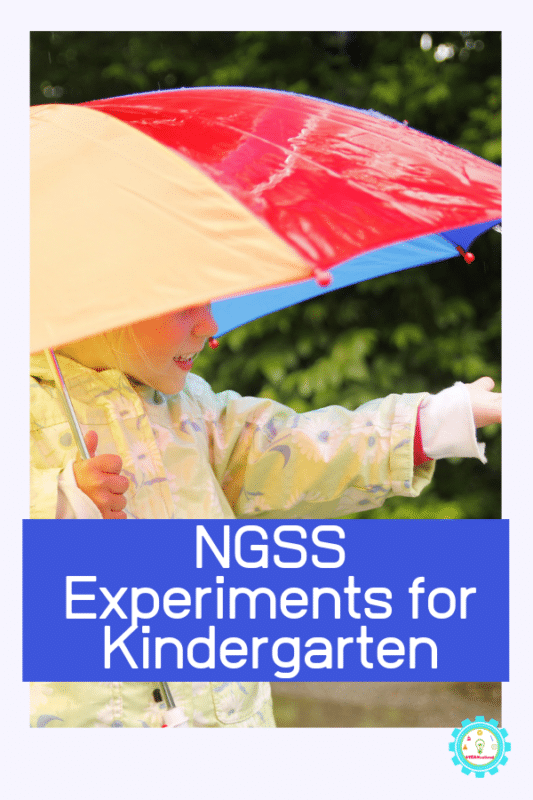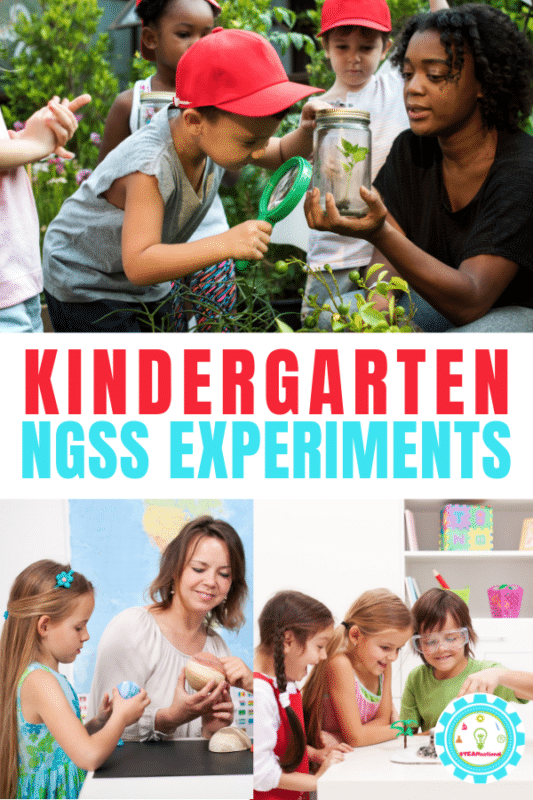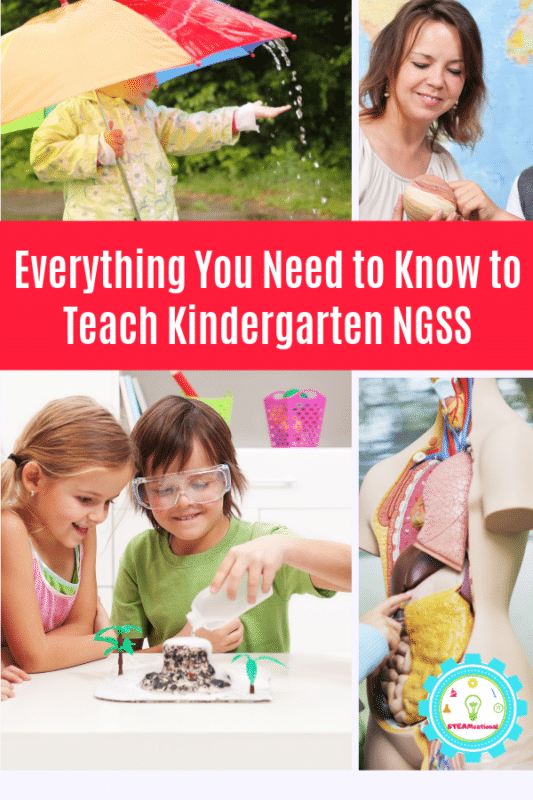Wondering what activities you can do to meet the Next Generation Science Standards for Kindergarten? Unpack the standards and find simple NGSS lesson plans for kindergarten here!
Can’t get enough NGSS science experiments? Check out the full list of Next Generation Science standards by grade level.
The Next Generation Science Standards for Kindergarten (often called kindergarten NGSS) offer a buildable framework for teaching science from the first year of school that continue to build through high school.
However, understanding NGS standards can be tricky, and finding NGSS kindergarten experiments can be even trickier.
Learn a little more about the NGSS kindergarten standards and some simple experiments you can use in your classroom here!

What are the Next Generation Science Standards?
Are you familiar with Next Generation Science Standards? NGSS for short (just don’t say NGSS standards!).

NGS standards were created and approved in 2013 as a new way to teach science and STEM as a comprehensive subject designed to supplement the common core science standards for kindergarten that builds on 3 dimensions:
- Core ideas (things to learn)
- Practices (how to do it)
- NGSS crosscutting concepts (how it fits in with other learning goals)
You can read more about NGSS and Next Generation Science Standrds by grade level here.
Next Generation Science Standards for Kindergarten
The NGS Standards for Kindergarten are a series of topics that include four main topics of study, and an overreaching umbrella of engineering and design concepts.
The units are meant to be completed throughout an entire school year. However, NGSS doesn’t provide tons of insight into what sort of science experiments will work with NGSS kindergarten standards.
You’re probably already familiar with the kindergarten standards if you’ve landed here, but here they are in a recap, just in case:
- K-PS2-1 Motion and Stability: Forces and Interactions
- Plan and conduct an investigation to compare the effects of different strengths or different directions of pushes and pulls on the motion of an object.
- K-PS2-2 Motion and Stability: Forces and Interactions
- Analyze data to determine if a design solution works as intended to change the speed or direction of an object with a push or a pull.
- K-LS1-1 From Molecules to Organisms: Structures and Processes
- Use observations to describe patterns of what plants and animals (including humans) need to survive.
- K-ESS2-1 Earth’s Systems
- Use and share observations of local weather conditions to describe patterns over time.
- K-ESS2-2 Earth’s Systems
- Construct an argument supported by evidence for how plants and animals (including humans) can change the environment to meet their needs.
- K-ESS3-1 Earth and Human Activity
- Use a model to represent the relationship between the needs of different plants and animals (including humans) and the places they live.
- K-ESS3-2 Earth and Human Activity
- Ask questions to obtain information about the purpose of weather forecasting to prepare for, and respond to, severe weather.
- K-ESS3-3 Earth and Human Activity
- Communicate solutions that will reduce the impact of humans on the land, water, air, and/or other living things in the local environment.
- K-2-ETS1-1 Engineering Design
- Ask questions, make observations, and gather information about a situation people want to change to define a simple problem that can be solved through the development of a new or improved object or tool.
- K-2-ETS1-2 Engineering Design
- Develop a simple sketch, drawing, or physical model to illustrate how the shape of an object helps it function as needed to solve a given problem.
- K-2-ETS1-3 Engineering Design
- Analyze data from tests of two objects designed to solve the same problem to compare the strengths and weaknesses of how each performs.
What is the Next Generation Science Standard Kindergarten Breakdown?

Basically, a kindergarten student covers:
- the pushes and pulls of an object to study cause and effect
- what animals and humans need to survive and how they can change their environments (adaptations and such)
- how to forecast weather and how to prepare for severe weather
- what changes humans can make to reduce the impact of humans on the environment
With this simplified breakdown, it’s easy to see what sort of actual science and STEM experiments kindergarten students should cover.
Remember, that while conducting these experiments, kindergarden students also should include the engineering design elements that include designing solutions with tools, making models, and analyzing data from each experiment to see which version worked the best.
NGSS Lesson Plans for Kindergarten
Below is a list of kindergarten science experiments that cover the requirements for each of the major elements of NGSS kindergarten standards. These NGSS lesson plans for kindergarten are low prep and tons of fun!
Topics covered include physics science experiments, weather science experiments, animal adaptation science experiments, environmental science experiments to complete the requirements for the Next Generation Science Standards for kindergarten.

Pushes and Pulls
The very most basic area of physics is forces and motion. In the Next Generation Science Standards for Kindergarten, students learn about pushes and pulls.
What Plants Need to Survive
Teach kindergarten students about the plant life cycle and what plants need to survive.
What Humans Need to Survive
Kindergarten students learn all about what they need to survive and remain healthy.
Healthy vs Unhealthy Food Sort
What Animals Need to Survive
Animals need specific things to survive. In this NGSS unit, kindergarten students learn what the needs of animals are.
Tracking Weather Patterns
In kindergarten, students learn to identify and track weather patterns throughout the year.
Animal and Human Environment Adaptations
Animals and humans adapt to their environment to make it more suitable for their needs. Kindergarten children can build models and test variables under this theme.
The relationship between the needs of plants and where they live
Just like animals, plants adapt too! This unit focuses on how what a plant does changes with what environment it is in.
The relationship between the needs of animals (including humans) and where they live
This teaches children how the needs of an animal are shaped by their environment, and how animals and humans adapt to whatever environment they are a part of.
Preparing for Severe Weather
Here, kindergarten students learn how to use tools to prepare for severe weather.
Using Clouds to Predict the Weather
Improving the Environment
The goal of this unit is to build models and demonstrations to illustrate how changes in human actions can improve the environment.
More STEM Activities for Kindergarten
50+ Engaging STEM Activities for Kindergarten that Foster Curiosity!
20+ Spring STEM Activities for Kindergarten to Celebrate Spring
Preschool and Kindergarten Zoo Counting Clip Cards 1-10
More Kinder STEM Activity Ideas

